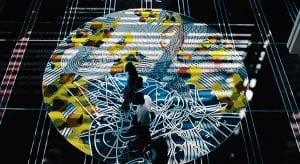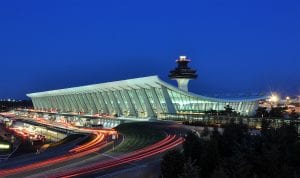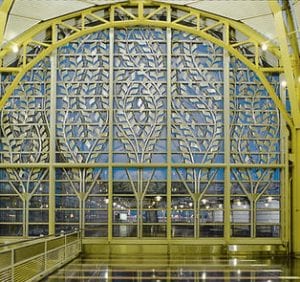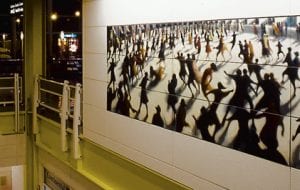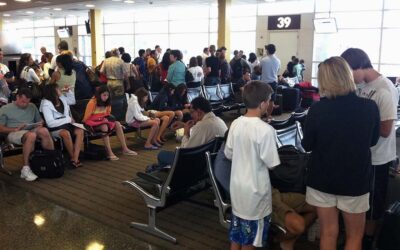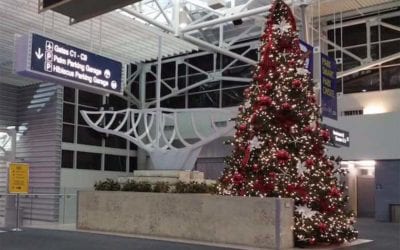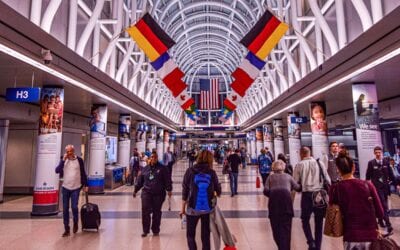Harried travelers are soothed by DC airport art
Art is making a comeback in airports and major metropolitan buildings. Washington’s Ronald Reagan National Airport (DCA) is a wonderful example of how airport art can be integrated into the architecture of a massive public structure. Its presence is subtle. Sometimes one has to search for it. But DC airport art soothes the soul of the harried traveler with quiet beauty.
For centuries, imposing edifices seemed to demand beautiful and integrated artwork. The Romans, the Church, medieval monarchs, and early U.S. builders all lavished decoration on their public buildings.
Then, for a short time, function trumped art (think Bauhaus design). Decorative details were deemed superfluous or too costly. Clean spaces and architectural details became an art in themselves. Office buildings and public spaces embraced a utilitarian world of blocks and cubicles.
Airport architecture became the art
Happily, around 1960, an inspired architect turned his attention to airports, and suddenly the lowly terminal became an art form. The TWA terminal at John F. Kennedy Airport had sweeping curves that seemed to take flight, and the original Dulles Airport building outside Washington, D.C., has a roofline that swoops over acres of glass. Both were Eero Saarinen designs. Thirty-five years later, Fentress Bradburn Architects gave us Denver International Airport, whose wonderful Teflon teepee roof mirrors the rugged Rocky Mountains that rise up behind it.
Now the balance is being restored between form and function. The dance between art and everyday life is being played out daily at Reagan National Airport, Denver International Airport, San Francisco International Airport, and in other public spaces. The recognition that art influences human behavior is also beginning to integrate itself into airport architecture.
DCA’s fabulous murals beneath your feet and climbing windows
At Reagan National Airport, the most prominent artwork is literally at your feet. Ten giant floor mosaics line the floor of the main concourse of Terminal C beneath a soaring, cathedral-like canopy. “Songs of Morning,” by Gregory Henry, and “Hooloomooloo,” by Frank Stella, all add splashes of color to an often hectic space. They give me pause every time I tread over them.
High above the gate level, colored-glass friezes and sculptures provide more decoration. They also change the color of the space as the sun traces its path across the sky. On the curtain wall of the ticketing level, Kent Bloomer’s “Foliated Trellis” provides the delicate treat of aluminum-and-steel vines creeping up an expanse of windows.
Artwork such as “Chalk Storks,” by Robert Vickery, and “The Rink,” by Bill Jacklin, adorn the walls in tucked-away spaces. And integrated into the railing along the ticketing level rise a series of ceramic panels in both abstract and figural designs. It all creates a warmer DC airport art experience.
Art adds a human dimension
Artwork like this is very welcome in airports. It adds a human dimension to concrete, glass, and steel. After all, airports are more than giant sheds. Their function is more than simply to move people from curbside-to-security-to-gate like so many items on an assembly line. We are humans, not simply cargo. Reducing stress is as important as efficiency.
Art reduces stress admirably. Studies in the psychology of art have shown that color and design have dramatic effects on humans. Art stirs the imagination and also mitigates anxiety. It adds a human element to structure and increases the pleasure of 

READ ALSO:
Check out cutting edge street art in the fresh air
Santa Fe sightseeing can be more than the city’s art
Please add any other airports that you feel have wonderful art from their architecture to their interior.

Charlie Leocha is the President of Travelers United. He has been working in Washington, DC, for the past 14 years with Congress, the Department of Transportation, and industry stakeholders on travel issues. He was the first consumer representative to the Advisory Committee for Aviation Consumer Protections appointed by the Secretary of Transportation from 2012 through 2018.

